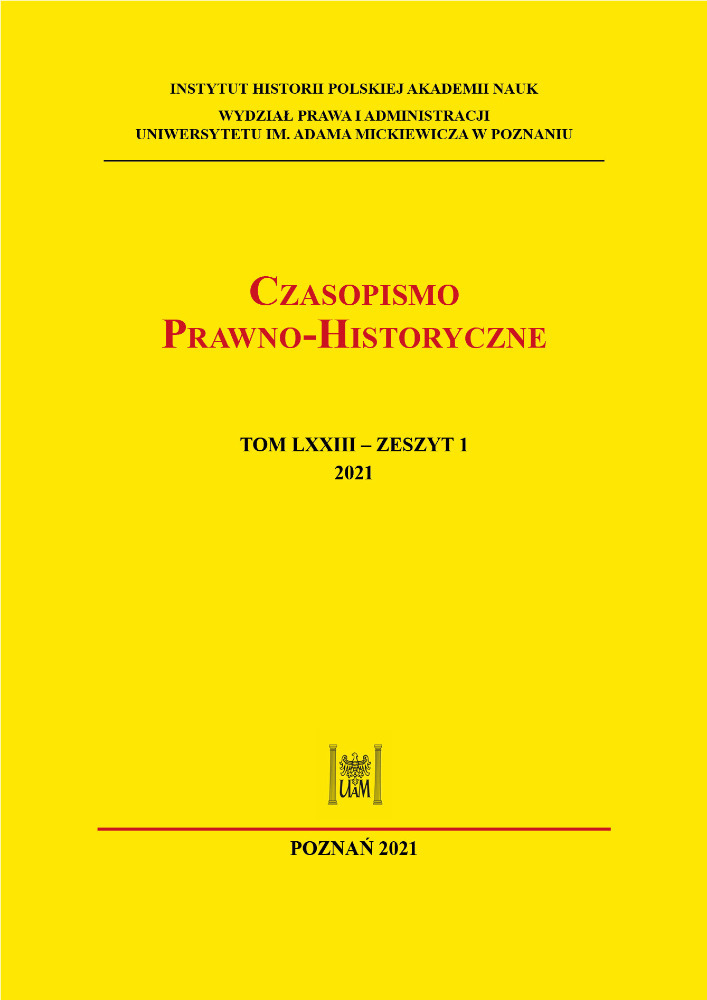Abstract
Being remanded in custody is a preventive measure which was already known in the Polish law of old. However, during the entire period of the existence of the Polish-Lithuanian Commonwealth, there was no regulation concerning the grounds for applying this measure, authorized entities or the admissible term of detention without a sentence of the court. Similarly, it was exceedingly rare to encounter separate places designated for temporarily holding people in custody. First concepts of principles concerning the execution of provisional detention only appeared in the second half of the 18th century. The final period of the Kingdom of Poland brought about practical reforms in the organization of the prison system also including reforms in the field of execution of pre-trial detention. Polish penitentiary scientists, who were under the influence of the European trends of the Age of Enlightenment, had a quite significant input in this field. One of them was Fryderyk Skarbek and thanks to him a modern detention centre, called Pawiak, which was designed to hold detainees during the investigation, was opened in Warsaw in 1835. The article presents the rules and regulations concerning the functioning of the Main Inquisitorial Prison which were based on the order issued on 26th of November/8 of December 1835 as well as on the comments to it which can be found in a document of the 11th/23rd of June 1858 in “Archiwum Główne Akt Dawnych” [The Central Archives of Historical Records].
References
Adamczyk T., O karze pozbawienia wolności w orzecznictwie krakowskiego sądu grodzkiego w XVIII wieku uwag kilka, „Z Dziejów Prawa” 2011, t. 4.
Czerwiec M., Więzienioznawstwo. Zarys rozwoju więziennictwa, Warszawa 1958.
Czołgoszewski J., Organizacja więziennictwa i służba więzienna w Królestwie Polskim w latach 1815–1868, „Przegląd Więziennictwa Polskiego” 2014, nr 85.
Czołgoszewski J., Więziennictwo Księstwa Warszawskiego, „Przegląd Więziennictwa Polskiego” 2010, nr 69.
Kaczyńska E., Ludzie ukarani. Więzienia i system kar w Królestwie Polskim 1815–1914, Warszawa 1989.
Makarewicz J., Polskie prawo karne. Część ogólna, Lwów – Warszawa 1919.
Ossibach-Budzyński A., Pawiak więzienie polityczne 1880–1915, Warszawa 2016.
Rabinowicz L., Podstawy nauki o więziennictwie, Warszawa 1933.
Senkowska M., Raport Fryderyka Skarbka o warszawskim więzieniu śledczym z 1828 r., „Czasopismo Prawno-Historyczne” 1957, t. IX, z. 2
Skarbek F., Statystyka. Wyjątek z raportu Hr. Skarbka o więzieniach Królestwa w roku 1830, „Gazeta Sądowa Warszawska” 1832, nr 59.
Akty prawne:
Zbiór Przepisów Administracyjnych Królestwa Polskiego, cz. VI: O aresztach i więzieniach, t. I, Warszawa 1868.
Źródła:
Archiwum Główne Akt Dawnych, zespół 227 Komisja Województwa Mazowieckiego/Rząd Gubernialny Warszawski, sygn. 10051.
License
Copyright (c) 2021 Justyna Bieda

This work is licensed under a Creative Commons Attribution-ShareAlike 4.0 International License.





